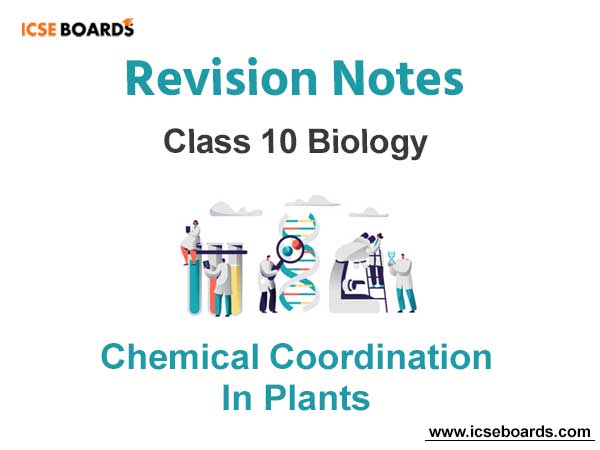Students should refer to Chemical Coordination in Plants ICSE Class 10 Biology notes provided below designed based on the latest syllabus and examination pattern issued by ICSE. These revision notes are really useful and will help you to learn all the important and difficult topics. These notes will also be very useful if you use them to revise just before your Biology Exams. Refer to more ICSE Class 10 Biology Notes for better preparation.
ICSE Class 10 Biology Chemical Coordination in Plants Revision Notes
Students can refer to the quick revision notes prepared for Chapter Chemical Coordination in Plants in Class 10 ICSE. These notes will be really helpful for the students giving the Biology exam in ICSE Class 10. Our teachers have prepared these concept notes based on the latest ICSE syllabus and ICSE books issued for the current academic year. Please refer to Chapter wise notes for ICSE Class 10 Biology provided on our website.
Chemical Coordination in Plants Cell Division ICSE Class 10 Biology
Chemical Coordination in Plants ICSE Class 10 Biology
TOPIC-1
Plant Growth Regulators
Quick Review
➢ Growth regulators include both naturally occurring as well as synthetic substances which modify growth.
➢ Growth regulators are either growth promoters e.g. Auxin, Gibberellins, and Cytokinins or growth inhibitors e.g. Abscisic acid (ABA) and ethylene.
➢ Auxins : Auxins were the first plant hormones to be discovered. In 1928 Went demonstrated its effects on plant.
➢ Chemically it was found to be Indol-3-Acetic Acid (IAA).
➢ IAA is the main naturally occurring auxin in plants.
➢ Physiological effects of Auxins –
(a) Cell elongation : Primary physiological effect of auxin in plant is to stimulate the elongation and growth of shoots.
(b) Cell division : Auxin is responsible for initiation and promotion of cell division in cambium.
(c) Root initiation : The auxin induce root formation in cuttings. In very low concentration auxins promote root growth but in higher concentration they inhibit the root growth but stimulate the formation of new roots.
(d) Callus formation : IAA promotes the development of callus in tissue culture. Callus is a mass of cells without any organization.
(e) Apical dominance : The terminal bud at the apex of shoot suppresses the development of lateral buds into branches. This is called apical dominance which can be induced by the application of auxins.
➢ Physiological effects of Gibberellins :
(a) Stem elongation : Gibberellins stimulate stem elongation and leaf expansion but have no effects on roots.
(b) Elongation of internodes : The gibberellins stimulate the elongation of internodes so much so that in many plants like dwarf pea, dwarf maize etc.
(c) Seed germination : Seeds of lettuce, barley etc. can be induced to germinate in dark when treated with gibberellins.
(d) Breaking of dormancy : Gibberellins treatment helps in breaking dormancy in seed potatoes resulting in uniform crop emergence.
(e) Sex – expression : Gibberellins usually cause maleness in plants i.e. they promote the production of male flowers.
(f) Flowering : Gibberellins promote flowering in many long day plants in short day unfavorable conditions.
➢Physiological effects of Cytokinins :
(a) Cell division : The cytokinins stimulate cell division and prevent ageing.
(b) Cell enlargement : Like auxin and gibberellins the cytokinins also cause enlargement of cells.
(c) Initiation of interfascicular cambium : Cytokinin induce the formation of interfascicular cambium in plants.
➢ Physiological effects of Abscisic acid (ABA)
(a) It induces dormancy in buds and seeds as opposed to gibberellic acid which breaks dormancy.
(b) It promotes the senescence of leaves, leaf fall and aging which can be effectively reverted by application of cytokinin.
(c) It inhibits lettuce seed germination.
(d) It inhibits gibberellins-induced growth in various tests and is believed to be a powerful gibberellin antagonist.
➢ Physiological effects of Ethylene –
(a) Induces ripening of fruits
(b) Inhibits elongation but induces isodiametric enlargements of cells.
(c) Stimulate seed germination in some species.
(d) Promotes leaf abscission
(e) Induces root hair formation
(f) Controls auxin levels in tissues.
TOPIC-2
Tropical Movements
Quick Review
➢ Plant movements in response to stimuli from some direction like light, gravity, chemicals and water are called tropic movements. It may be favourable towards the stimulus when it is positive or away from the stimulus when it is negative.
➢ Phototropism : This is the growth movement of curvature induced by external stimulus of light. The shoots bend towards light (positively phototropic) while roots move away from light (negatively phototropic).
➢ Geotropism : Growth movements induced by the stimulus of gravity are known as geotropism. Shoot system grows away from gravity, negatively geotropic, the roots grow towards gravity , positively geotropic. Some organs do not respond to geotropic stimulus and are called ageotropic. e.g. coralloid roots of cycas.
➢ Hydrotropism : Growth movements in response to external stimulus of water is called as hydrotropism. Roots bend towards the source of water and are called positively hydrotropic.
➢ Thigmotropism : These are the movements due to contact with a foreign body. Tendrils, twinners, petiole of clematis show thigmotropic movements. Poor growth on the side of contact and more growth on the other side results in coiling.
➢ Chemotropism : The curvature takes place due to some chemical stimulus. Fungal hyphae, pollen tube exhibit positive chemotropic movements due to some chemicals.
Know the Terms
➢ Growth : It is permanent irreversible increase in size, weight, volume of organism or its parts.
➢ Seed dormancy : It is the inherent inhibition of seed germination due to internal unfavourable conditions even if external conditions are favorable.
➢ Seed germination : It is the process in which dormant embryo resumes its activities and growth in favourable conditions after dormancy period is overcome.
➢ Abscission : It is shedding of leaves, flowers or fruits due to hormonal imbalance.
➢ Senescence : It is the ageing of plants due to increase of age and plant’s part stop functioning gradually and ultimately die.
➢ Apical dominance : It is the process of suppression of lateral buds by apical buds which lie near it.
➢ Phenology : It deals with the study of different appearances of plants in different seasons of the year.
➢ Bolting : It is stimulation of internodal growth just before reproduction



